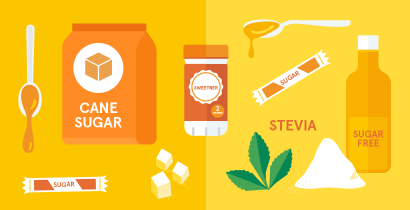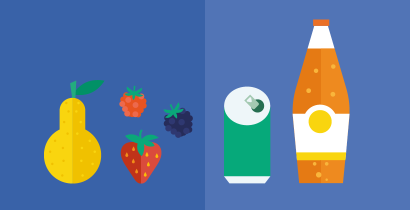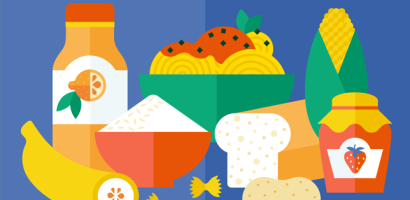What is The Role of Sugar in the Food Industry?
Last Updated : 06 March 2013The word “sugar” brings to mind the white crystals that make our lives sweeter. However, sugars are not only used as sweeteners but have important technological functions in foods, providing texture, bulk, colour and acting as preservative agents.
Origin of sugar
Sugars are naturally present in fruits and vegetables (sucrose, glucose and fructose), honey (fructose and glucose), as well as in milk and dairy products (lactose and galactose) and to a lesser extent in cereals (maltose) (see “Sugars: Addressing common questions and debunking myths”). The main sugar used in our kitchens is sucrose (table sugar), which is composed of the two sugars, glucose and fructose. Sucrose is extracted with water from sugar cane and sugar beet, where it is present in large quantities. The resulting sugar juice is purified, filtered and concentrated to syrup, from which sucrose is crystallised, dried and cooled. The residual dark syrupy material is molasses. The ‘white sugar’ thus isolated is neither chemically altered nor bleached. White sugar is available in different types of granulated sugar. Brown sugar retains some of the molasses, which imparts characteristic flavours and colours.
Technological applications:
Sweetener
White and brown crystalline sugars are used as sweeteners in home cooking and the food industry. Powdered sugars are used as icing sugar in baking and confectionery. Sugar syrups are used in beverages or as a base for fruit sauces, toppings and flavoured syrups. Sugars are also used to counter acidic and bitter tastes, e.g. in tomato sauces, mayonnaise or in medical syrups.
Texture, volume and moisture
Sugars play a major role in defining the bulk (volume) and texture (mouthfeel) of foods. For example, sugars provide volume to cakes and biscuits. The combination of sugar with a gelling agent (e.g. pectin) is responsible for the jelly texture of jams. In baked products sugar increases the starch gelatinisation temperature, trapping air bubbles and delivering a light texture to cakes. Sugars also provide the base for yeast fermentation (e.g. in rising bread). Sugar is a humectant (binds water), which is important in food preservation and also affects texture. Sugars also reduce the freezing point, important for producing softer ice creams, and increase the boiling point, which is important in manufacture of sweets.
Colour
Sugars are responsible for the development of the brown colour of many cooked foods, through two processes: the Maillard reaction and caramelisation.1 The golden-brown crust of baked products, such as biscuits and toasted bread, is due to the Maillard reaction, occurring under heat between sugars (predominantly glucose and fructose) and amino acids (proteins). In caramelisation, sugars (mainly sucrose, glucose and fructose) are broken down under heat, producing new molecules which provide colour and flavour, e.g. in products like caramel sauce and caramelised fruits and sweets.
Food preservation
Sugars are also important in food preservation. Marmalades, syrupy fruit desserts, candied fruits and other delicacies were born out of the historical need to preserve fresh produce. The high sugar content prevents microbial growth and spoilage by increasing the osmotic pressure, which limits microbial growth and makes these foods last longer.
Alcoholic beverages
Sugars are also at the heart of alcoholic fermentation, i.e. the conversion of sugars to ethanol (alcohol) by yeasts, which is used to make alcoholic beverages. Sugars contained in grapes, grains, honey and fruits are used in the production of wine, beer and whisky, mead and ciders respectively.
Reducing sugar in foods
In light of the high prevalence of obesity and overweight, public health efforts are aimed at reducing the number of calories people consume, including reducing the energy density (calories per gram) of processed foods by decreasing total fats and carbohydrates, including sugar. Food and beverage companies are responding to public health policies such as that of the European Commission by reformulating food and drinks and reducing their energy content where technically possible.
Product reformulation however is not always straightforward. Sugars are responsible for many properties of food and thus they cannot usually be replaced by a single ingredient.2 Removing or replacing sugar will change the characteristics (taste, texture, appearance) of a food. To compensate, we may need to change the whole recipe, resulting in a different product. At the same time, reformulation must respect consumer preferences and the expectations they have from their favourite products. Sometimes the replacement compound may have the same calories as sugar. For example sugar in breakfast cereals may be replaced with starch, another carbohydrate, which contains the same amount of calories. Therefore, reducing sugar may not necessarily result in fewer calories; consumers may expect foods that are “reduced or low in sugars” or have “no added sugars” to contain fewer calories.3 Finally, sugars play an important role in food preservation and extending shelf-life. Consequently, care should be taken when reducing or replacing sugars to ensure the reformulation product meets consumer expectations and maintain food safety.
References
- Cooper JM. (2012). Product Reformulation – can sugar be replaced in foods? Int Sugar J 114(1365):642–5.
- Nursten H. (2005). The Maillard Reaction: Chemistry, Biochemistry and implications (1st ed). Cambridge, UK: Royal Society of Chemistry.
- Patterson NJ et al. (2012). Consumer Understanding of sugar claims on food and drink products. Nutr Bull 37:121–30.



